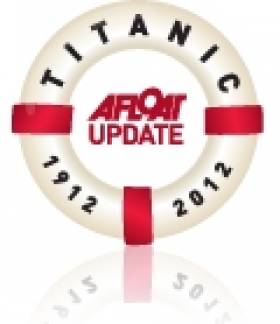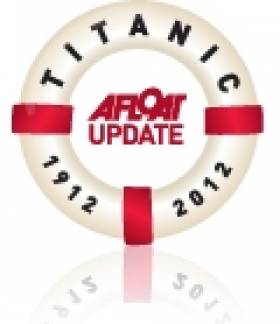Displaying items by tag: Liners
Maritime Institute to Host Tributes to Titanic
#TITANIC 100 – In this centenary week of the sinking of RMS Titanic a talk and musical tribute will be held in memory of the disaster this evening (8 pm) in the newly opened maritime museum in Dun Laoghaire as previously reported on Afloat.ie.
Deep-sea diver Rory Golden became the first Irishman to see the wreck of the Titanic and he will present an illustrated lecture. The musical tribute will be led by uillinn piper Eamon Galdubh – where similar music will be aired to that played in the 2nd and 3rd class compartments on the Titanic.
In addition the Maritime Institute of Ireland (M.I.I.) which runs the museum will run its final lecture for the season next week. The lecture 'Titanic -Locked in History' which will be held next Thursday (19th April) at 8pm in the Stella Maris Seafarers Club in Dublin city-centre and is to be presented by Michael O'Flaherty.
For information on both the Titanic Tribute evening (tickets cost €10) call 087 900 7466 and by also viewing the website which includes details about next week's admission free lecture visit: www.mariner.ie
President Visits Cobh Commemoration of Titanic 100
#COBH TITANIC 100 – President Michael D Higgins attended a ceremony in Cobh, Co Cork this afternoon to mark the 100th anniversary of Titanic's maiden voyage.
The liner's last port of call was to Cobh (then Queenstown) and was where the last passengers boarded the White Star Line's liner.
The tribute, part of Cobh's Titanic 100 programme of commemorative events, saw a naval fleet review and a flyover from the Irish Air Corps. For more the Irish Examiner has a report.
'Titanic Port’ Book Launched
A new book celebrating 400 years of the development of Belfast Harbour was launched on Monday in the offices of Belfast Harbour Commissioners. 'Titanic Port' was written by award-winning journalist and author Alf McCreary, and was commissioned by the port authority. For a full account of the book launch please click here (which includes a link to a podcast by the author).
The book tells the story of those who built the harbour and the foundations for Belfast's emergence as a major urban and commercial centre. The book traces the harbour records, dating back to 1613 when King James I authorised the construction of a small wharf on the river Lagan.
At over 400 pages long, 'Titanic Port' also contains over 700 illustrations, many previously unseen photographs and paintings from the harbour's archives, including panoramic port and city views.
A central theme of the book is the intimate relationship between Belfast and its harbour and how the Belfast Harbour Commissioners were instrumental in bringing shipbuilding to the city. In particular, how they helped ensure that Titanic and her sister ships, Olympic and Britannic were built at Queen's Island. In addition the Commissioners investment of the Thompson Dock, where the trio of iconic liners were fitted out, was the largest of its kind in the world.
The cost of the dock was almost the same price as the Titanic and was specifically built to help Harland & Wolff secure the contract from the ships' owners, the White Star Line.
'Titanic Port' also follows the development of the Jacobean and Georgian port which was barely navigable due to Belfast Lough's treacherous mud-banks and sandbanks. Without the creation of a navigable channel over the centuries by successive harbour authorities, it is arguable that Carrickfergus might have become Ulster's main seaport.
Also examined is the vital role the harbour during both World Wars I and II and how the Harbour Estate escaped the worst of the 'Troubles' and its recent re-emergence as a major economic driver for Northern Ireland's economy. The social history of Belfast is also explored and how it influenced the port, in particular, Sailortown.
'Titanic Port' is currently on sale priced £25 (stg) and available online at http://www.titanicport.comThe book was produced by Dr. Claude Costecalde of Booklink and designed by Wendy Dunbar.
For information in general about Belfast Harbour Commissioners logon to www.belfast-harbour.co.uk/


























































